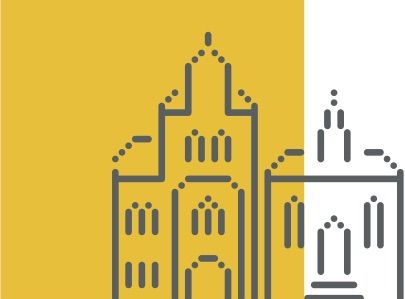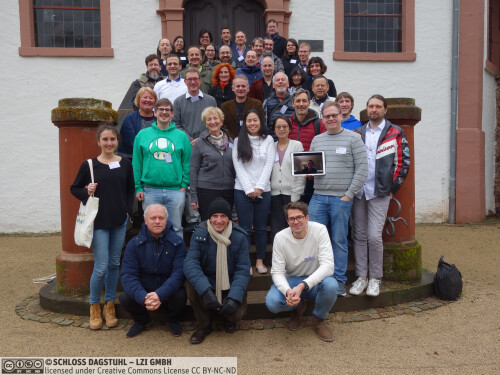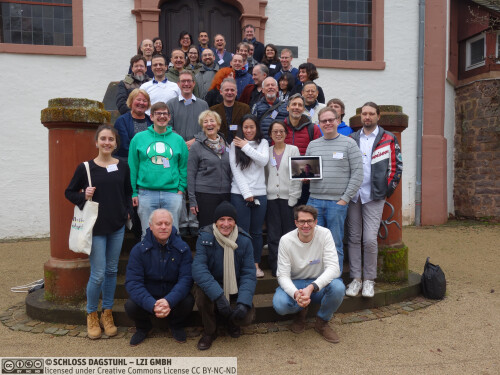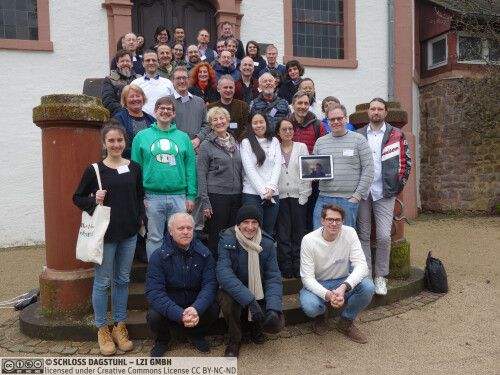Dagstuhl-Seminar 23051
Perception in Network Visualization
( 29. Jan – 03. Feb, 2023 )
Permalink
Organisatoren
- Karsten Klein (Universität Konstanz, DE)
- Stephen Kobourov (University of Arizona - Tucson, US)
- Bernice E. Rogowitz (Visual Perspectives - New York, US)
- Danielle Szafir (University of North Carolina at Chapel Hill, US)
Kontakt
- Marsha Kleinbauer (für wissenschaftliche Fragen)
- Simone Schilke (für administrative Fragen)
Impacts
- On the Perception of Small Sub-graphs : article in Graph Drawing and Network Visualization (GD 2023) - Miller, Jacob; Ghoniem, Mohammad; Wu, Hsiang-Yun; Purchase, Helen C. - Berlin : Springer, 2023. - pp 213–230 - (Lecture notes in computer science ; 14465 ; article).
- GraphTrials : Visual Proofs of Graph Properties : article in 32nd International Symposium on Graph Drawing and Network Visualization (GD 2024) - Förster, Henry; Klesen, Felix; Dwyer, Tim; Eades, Peter; Hong, Seok-Hee; Kobourov, Stephen G.; Liotta, Giuseppe; Misue, Kazuo; Montecchiani, Fabrizio; Pastukhov, Alexander; Schreiber, Falk - Wadern : LZI, 2024. - pp. 16:1–16:18 - (Leibniz International Proceedings in Informatics ; 320 : article).
- Visualization and Automation in Data Science : Exploring the Paradox of Humans-in-the-Loop : article in 2024 IEEE Visualization in Data Science (VDS) - Rogers, Jen; Chakhchoukh, Mehdi; Faust, Rebecca; Koch, Steffen; Wall, Emily; Turkay, Cagatay; Kotthoff, Lars; Kerren, Andreas; Bernard, Jürgen; Anastacio, Marie - Los Alamitos : IEEE, 2024. - 5 pp..
- Time-Dependent Route Planning on Maps : A User Study - Bonerath, Annika; Carbon, Claus-Christian; Miksch, Silvia; Patrignani, Maurizio; Tappini, Alessandra - Springfield : Society for Imaging Science and Technology, 2025. - 12 pp. - (Journal of Perceptual Imaging ; 2025, February).
Programm
The Dagstuhl Seminar "Perception in Network Visualization" addressed the issue that both established knowledge and current research on human perception are not represented well in network visualization research, and in particular not explicitly taken into account in the development of methods and measures for effective network representation.
A main goal of the seminar thus was to investigate the foundations of network visualization in the context of human perception and cognition. This included raising awareness in the network visualization community about potential gaps in the current state of the art, identifying specific research questions to fill these gaps, investigating the selected questions, and creating an agenda for future research. Similarly, we wanted to increase awareness in the perception community that challenges in network visualization research can drive new questions for perception research. An important purpose of the seminar was to engage network visualization researchers to increase the efforts to take into account knowledge on perception -- its limits but also opportunities -- when designing and evaluating network visualization approaches. The mechanisms and impact of specific perceptual phenomena are currently underexplored in network visualization research, and we wanted to put the investigation of these topics more prominently on the research agenda. To this end, the seminar initiated exchange between researchers in the network visualization community and researchers studying perception.
Perception can play an important role in nearly all aspects of network visualization. We aimed to cover diverse aspects in the topics investigated during the seminar, with the following short list serving as a starting point for further discussions:
- Fundamentals of perception in relation to network visualization: Basic questions about how humans read network visualizations in the context of specific network characteristics and tasks are not yet well understood. We would like to investigate some of these questions, including: What are main features that humans recognize and memorize from different network representations? How well can these features be distinguished? How sensitive are people to changes in these features? What are the main features that support orientation and navigation in large networks? What are the relationships between insight generation, perception and interaction in interactive exploration scenarios?
- Quality metrics and layout styles: Many quality metrics and optimization goals for different layout styles have been proposed (e.g., number of crossings, stress, number of bends). We want to investigate whether these metrics and goals are motivated or justified by modern theories of perception and align these metrics with relevant empirical evidence. Can the current knowledge on perception explain why certain approaches work better than others?
- Experimental design: Investigating the above questions requires new experimental paradigms that consider the complex relationship between elements in network visualizations (e.g., nodes and edges) and the insights that people develop with such visualizations. Experimental methods must both investigate perceptual aspects of network visualization and provide meaningful evaluations of new metrics and approaches.
- Guidelines: Network visualization covers more than algorithmic aspects, such as choosing different channels to represent data visually. Is it possible to develop guidelines that help steer the complex design process using perceptual principles?
Acknowledgments
We would like to thank all participants of the seminar for their contributions and lively discussions, and the scientific directorate of Dagstuhl for providing us with the opportunity to organize this seminar. Finally, the seminar would not have been possible without the amazing support by the staff of Dagstuhl.
 Karsten Klein, Stephen G. Kobourov, Bernice E. Rogowitz, and Danielle Szafir
Karsten Klein, Stephen G. Kobourov, Bernice E. Rogowitz, and Danielle Szafir
Networks are used to model and represent a large variety of data in many application areas from life sciences to social sciences. Visual network analysis is a crucial tool to improve the understanding of data sets and processes over many levels of complexity, e.g., semantic, spatial and temporal granularity. While there is a great deal of work on the algorithmic aspects of network visualization and the computational complexity of the underlying problems, the role and limits of human perception are rarely explicitly investigated and taken into account when designing network visualizations.
To address this issue, this Dagstuhl Seminar is meant to increase awareness in the network visualization community of the need for more extensive theoretical and empirical understanding of how people perceive and make sense of network visualizations and the significant potential for improving current solutions when perception-based strategies are employed. Likewise, the seminar is supposed to increase awareness in the perception community that challenges in network research can drive new questions for perception research, for example, in identifying features and patterns in large, often time-varying networks. We would like to bring together researchers in the communities to initiate a dialogue, foster exchange, discuss the state of the art at this intersection and within the respective fields, identify promising research questions and directions, and start working on selected problems.
Perception can play an important role in nearly all aspects of network visualization and we aim to cover diverse aspects in the topics that will be investigated during the seminar, with the following short list serving as a starting point for further discussions:
- Fundamentals of perception in relation to network visualization: Basic questions about how humans read network visualizations in the context of specific network characteristics and tasks are not yet well understood. We would like to investigate some of these questions, including: What are main features that humans recognize and memorize from different network representations? How well can they be distinguished and how sensitive are people to changes in these features? What are the main features that support orientation and navigation in large networks? What are the relationships between insight-generation, perception and interaction in interactive exploration scenarios?
- Quality metrics and layout styles: Many quality metrics and optimization goals for different layout styles have been proposed (e.g., number of crossings, stress, number of bends). We want to investigate whether these metrics and goals are motivated or justified by modern theories of perception, and whether empirical evidence exists to support them. Can the current knowledge on perception explain why certain approaches work better than others?
- Experiment design: Investigating the above questions requires new experimental paradigms that consider the complex relationship between elements in network visualizations (e.g., nodes and edges) and the insights that people develop with such visualizations. Experimental methods must both investigate perceptual aspects of network visualization and provide meaningful evaluations of new metrics and approaches.
- Guidelines: Network visualization covers more than algorithmic aspects. Is it possible to develop guidelines that help steer the complex design process using perceptual principles?
 Karsten Klein, Stephen G. Kobourov, Bernice E. Rogowitz, and Danielle Szafir
Karsten Klein, Stephen G. Kobourov, Bernice E. Rogowitz, and Danielle Szafir
- Michael Aichem (Universität Konstanz, DE) [dblp]
- Daniel Archambault (Swansea University, GB) [dblp]
- Cindy Xiong Bearfield (University of Massachusetts - Amherst, US) [dblp]
- Annika Bonerath (Universität Bonn, DE) [dblp]
- Rita Borgo (King's College London, GB) [dblp]
- Claus-Christian Carbon (Universität Bamberg, DE) [dblp]
- Tim Dwyer (Monash University - Clayton, AU) [dblp]
- Peter Eades (The University of Sydney, AU) [dblp]
- Henry Förster (Universität Tübingen, DE) [dblp]
- Mohammad Ghoniem (Luxembourg Inst. of Science & Technology, LU) [dblp]
- Carsten Görg (University of Colorado - Aurora, US) [dblp]
- Seok-Hee Hong (The University of Sydney, AU) [dblp]
- Christophe Hurter (ENAC - Toulouse, FR) [dblp]
- Andreas Kerren (Linköping University, SE) [dblp]
- Karsten Klein (Universität Konstanz, DE) [dblp]
- Felix Klesen (Universität Würzburg, DE)
- Stephen Kobourov (University of Arizona - Tucson, US) [dblp]
- Oliver Kohlbacher (Universität Tübingen, DE) [dblp]
- Giuseppe Liotta (University of Perugia, IT) [dblp]
- Mauro Martino (MIT-IBM Watson AI Lab - Cambridge, US) [dblp]
- Tamara Mchedlidze (Utrecht University, NL) [dblp]
- Natalia Melnik (Otto-von-Guericke-Universität Magdeburg, DE)
- Silvia Miksch (TU Wien, AT) [dblp]
- Jacob Miller (University of Arizona - Tucson, US)
- Kazuo Misue (University of Tsukuba, JP) [dblp]
- Fabrizio Montecchiani (University of Perugia, IT) [dblp]
- Carolina Nobre (University of Toronto, CA) [dblp]
- Martin Nöllenburg (TU Wien, AT) [dblp]
- Alexander Pastukhov (Universität Bamberg, DE) [dblp]
- Maurizio Patrignani (University of Rome III, IT) [dblp]
- Helen C. Purchase (Monash University - Clayton, AU) [dblp]
- Marius Raab (Universität Bamberg, DE) [dblp]
- Bernice E. Rogowitz (Visual Perspectives - New York, US) [dblp]
- Paul Rosen (University of Utah - Salt Lake City, US) [dblp]
- Falk Schreiber (Universität Konstanz, DE) [dblp]
- Danielle Szafir (University of North Carolina at Chapel Hill, US) [dblp]
- Alessandra Tappini (University of Perugia, IT) [dblp]
- Alexandru C. Telea (Utrecht University, NL) [dblp]
- Markus Wallinger (TU Wien, AT)
- Hsiang-Yun Wu (FH - St. Pölten , AT) [dblp]
Verwandte Seminare
- Dagstuhl-Seminar 26361: Perception-Informed Network Visualization: Visual and Interaction Design (2026-08-30 - 2026-09-04) (Details)
Klassifikation
- Data Structures and Algorithms
- Human-Computer Interaction
Schlagworte
- Network Visualization
- Graph Drawing
- Perception
- Cognition




 Creative Commons BY 4.0
Creative Commons BY 4.0
